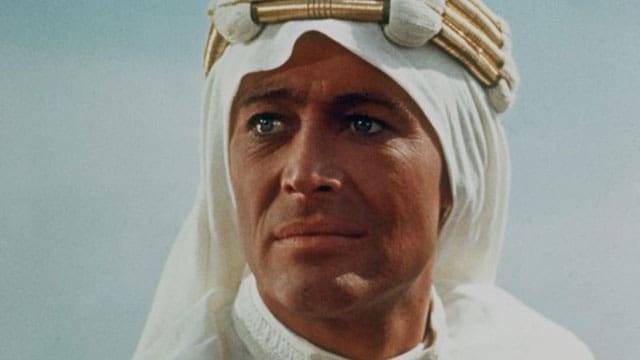The remarkable career of Peter O’Toole, from his iconic roles to his deep connection to his Irish heritage
 While meaning no disrespect to the estimable Cillian Murphy, I regard the late Peter O’Toole as Ireland’s greatest screen actor. Granted, Murphy has a Best Actor Oscar to his name, a distinction that eluded O’Toole despite being nominated eight times over a career spanning 50 years. But there’s also the matter of body of work to consider.
While meaning no disrespect to the estimable Cillian Murphy, I regard the late Peter O’Toole as Ireland’s greatest screen actor. Granted, Murphy has a Best Actor Oscar to his name, a distinction that eluded O’Toole despite being nominated eight times over a career spanning 50 years. But there’s also the matter of body of work to consider.
As for the Irish bit, it’s been pointed out that registry office records for 1932 list O’Toole as being born in the north of England town of Leeds. And nobody disputes the fact that he grew up in the surrounding region.
Still, O’Toole often talked about being born in his Irish father’s native County, Galway, after which the family immediately moved to England. And he certainly displayed a lifelong affinity for his Irish heritage, held an Irish passport, insisted that his daughters be born in Ireland, built a house in Connemara and ended up having his ashes sprinkled there.
 Peter O’Toole |
| Related Stories |
| Is it rude to point out the historical inaccuracies in Napoleon?
|
| Michael Caine is still going strong at 90
|
| Maureen O’Hara, Ireland’s Queen of Technicolor
|
There were countless movies over the years, including some real clunkers. But O’Toole could also be magnificent. Here are a few examples.
Lawrence of Arabia (1962)
The movie that catapulted Peter O’Toole from obscurity to international stardom was one of those multi-hour roadshow productions that became very popular in the 1960s. Running a bit shy of four hours and shown with an intermission, it was more of an evening out than your regular trip to the cinema. It was also hugely successful, both commercially and in terms of critical acclaim – 10 Oscar nominations and seven wins, including Best Picture and Best Director.
For director David Lean, Lawrence of Arabia was the middle entry in a career-defining purple patch. Immediately preceded by The Bridge on the River Kwai and followed by Doctor Zhivago, it constituted a trio of major epics that set a standard impossible to maintain.
The movie’s title character was T. E. Lawrence, the Englishman who played an important part in the First World War’s Arab revolt against the Ottoman Empire. Although O’Toole was neither the first nor second choice for the role, he made it entirely his own, projecting an intense presence throughout.
He was also physically quite different from the real Lawrence, being about nine inches taller and cutting a dashing figure in his flowing white robes. As his friend Noel Coward teasingly put it: “If you’d been any prettier, it would have been Florence of Arabia.”
Much later, Lean acknowledged a “pervasively homoerotic” sensibility in the film, as if they were pushing the boundaries of the day. It was an aspect that entirely eluded me when I first saw it over 60 years ago.
Amidst all of the enthusiasm, there were critics who took issue with the movie’s historical accuracy. In addition to the fictionalization of various sequences, there was the matter of character representation. Lawrence’s younger brother campaigned against it, the family of General Edmund Allenby issued a formal complaint, and the descendants of two of the Arab characters sued.
Lawrence of Arabia shouldn’t be confused with a documentary. While inspired by actual historical events and personalities, it’s an engrossing, sweeping epic – neither more nor less.
Becket (1964) and The Lion in Winter (1968)
Providing O’Toole with what I consider his best-ever role, these two films should be considered a set. The character he portrays is the 12th-century Frenchman (from Anjou) who became Henry II of England in 1154. And by adding England to his existing continental possessions, he controlled a territorial agglomeration stretching from the Scottish border to the Pyrenees. This made him one of Western Europe’s most powerful figures.
Both films had their origins in the theatre, being adaptations of plays from 1959 (Becket) and 1966 (The Lion in Winter). This provenance particularly shows in the latter, giving us some sparkling verbal cut-and-thrust between O’Toole and Katherine Hepburn (playing Henry’s wife, the legendary Eleanor of Aquitaine).
In Becket, Henry’s age ranges from early 20s to just over40y. He’s a man at the peak of his powers, determined to prevail in the authority competition between Crown and Church.
The Lion in Winter, for its part, brings us an older Henry, a man struggling to hold off his rebellious sons and the French king who hopes to benefit from the familial discord.
Historically, both films are substantively accurate, the only significant error being the depiction of Becket as a Saxon, thus adding a mistaken conqueror/conquered dimension to the conflict. As for Peter O’Toole, his powerful rendering of Henry rings true to the historical record.
If you’ve never seen them, give yourself a treat.
Troy Media columnist Pat Murphy casts a history buff’s eye at the goings-on in our world. Never cynical – well, perhaps a little bit.
For interview requests, click here.
The opinions expressed by our columnists and contributors are theirs alone and do not inherently or expressly reflect the views of our publication.
© Troy Media
Troy Media is an editorial content provider to media outlets and its own hosted community news outlets across Canada.

